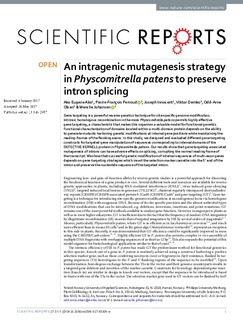| dc.contributor.author | Ako, Ako Eugene | |
| dc.contributor.author | Perroud, Pierre-François | |
| dc.contributor.author | Innocent, Joseph | |
| dc.contributor.author | Demko, Viktor | |
| dc.contributor.author | Olsen, Odd-Arne | |
| dc.contributor.author | Johansen, Wenche | |
| dc.date.accessioned | 2017-12-21T14:31:49Z | |
| dc.date.available | 2017-12-21T14:31:49Z | |
| dc.date.issued | 2017 | |
| dc.identifier.citation | Scientific Reports 7, Article number: 5111 (2017) doi:10.1038/s41598-017-05309-w | nb_NO |
| dc.identifier.issn | 2045-2322 | |
| dc.identifier.uri | http://hdl.handle.net/11250/2473585 | |
| dc.description | This is an Open Access article licensed under a Creative Commons Attribution 4.0 International License) and originally published in Scientific Reports. You can access the article on the publiser's website by following this link: https://www.nature.com/articles/s41598-017-05309-w Dette er en vitenskapelig, fagfellevurdert artikkel som opprinnelig ble publisert i Scientific Reports. Artikkelen er publisert under lisensen Creative Commons Attribution 4.0 International License. Du kan også få tilgang til artikkelen på utgivers hjemmeside ved å følge denne lenken: https://www.nature.com/articles/s41598-017-05309-w | nb_NO |
| dc.description.abstract | Gene targeting is a powerful reverse genetics technique for site-specific genome modification. Intrinsic homologous recombination in the moss Physcomitrella patens permits highly effective gene targeting, a characteristic that makes this organism a valuable model for functional genetics. Functional characterization of domains located within a multi-domain protein depends on the ability to generate mutants harboring genetic modifications at internal gene positions while maintaining the reading-frames of the flanking exons. In this study, we designed and evaluated different gene targeting constructs for targeted gene manipulation of sequences corresponding to internal domains of the DEFECTIVE KERNEL1 protein in Physcomitrella patens. Our results show that gene targeting-associated mutagenesis of introns can have adverse effects on splicing, corrupting the normal reading frame of the transcript. We show that successful genetic modification of internal sequences of multi-exon genes depends on gene-targeting strategies which insert the selection marker cassette into the 5′ end of the intron and preserve the nucleotide sequence of the targeted intron. | nb_NO |
| dc.language.iso | eng | nb_NO |
| dc.publisher | Nature Publishing Group | nb_NO |
| dc.rights | Navngivelse 4.0 Internasjonal | * |
| dc.rights.uri | http://creativecommons.org/licenses/by/4.0/deed.no | * |
| dc.subject | genteknologi | nb_NO |
| dc.subject | gene targeting | nb_NO |
| dc.title | An intragenic mutagenesis strategy in Physcomitrella patens to preserve intron splicing. | nb_NO |
| dc.type | Journal article | nb_NO |
| dc.type | Peer reviewed | nb_NO |
| dc.subject.nsi | VDP::Teknologi: 500::Bioteknologi: 590 | nb_NO |
| dc.source.pagenumber | 10 | nb_NO |
| dc.source.volume | 7 | nb_NO |
| dc.source.journal | Scientific Reports | nb_NO |
| dc.source.issue | Article number: 5111 | nb_NO |
| dc.identifier.cristin | 1498910 | |

